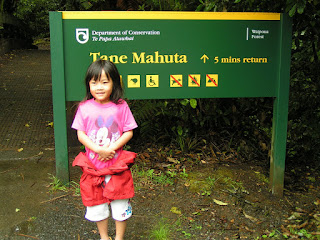On the way home to Auckland, we took the western coast and paid a visit to Tane Mahuta in the Waipoua Forest- a 2000 year old Kauri Tree which is about 50 metres tall . Its huge, really majestic.




It was difficult to photograph the whole tree and still be in the picture so if you look really really hard, you can see a pin-size Ren at the bottom of the next picture.





It was difficult to photograph the whole tree and still be in the picture so if you look really really hard, you can see a pin-size Ren at the bottom of the next picture.

Our final stop was the Kauri Museum in Matakohe where we saw some fascinating kauri exhibits.
 Bath tubs were once made of kauri......
Bath tubs were once made of kauri......







A cross section of a kauri tree......
 Bath tubs were once made of kauri......
Bath tubs were once made of kauri......
Inside a kauri tree trunk...

Boarding house of the 1900s...

Kauri art pieces.....

Kauri home deco and furniture......


and Kauri gum...

oops, Erica almost lost her finger to kauri fish!










 We lunched there then went a little tour of the island. Pompallier Mission, NZ's oldest surviving Roman Catholic building was one of the stops.
We lunched there then went a little tour of the island. Pompallier Mission, NZ's oldest surviving Roman Catholic building was one of the stops. 
 It was originally used as the headquarters of the Catholic mission to Western Oceania. The building is built of rammed earth within a kauri framework. The part of the building we visited was the printery, tannery and storehouse for the Marist mission of Bishop Pompallier.
It was originally used as the headquarters of the Catholic mission to Western Oceania. The building is built of rammed earth within a kauri framework. The part of the building we visited was the printery, tannery and storehouse for the Marist mission of Bishop Pompallier.  The visit was most interesting for Tim since Bishop Pompallier is often mentioned in school, and the ship on which Bishop Pompallier sailed on appears on his school badge.
The visit was most interesting for Tim since Bishop Pompallier is often mentioned in school, and the ship on which Bishop Pompallier sailed on appears on his school badge.


